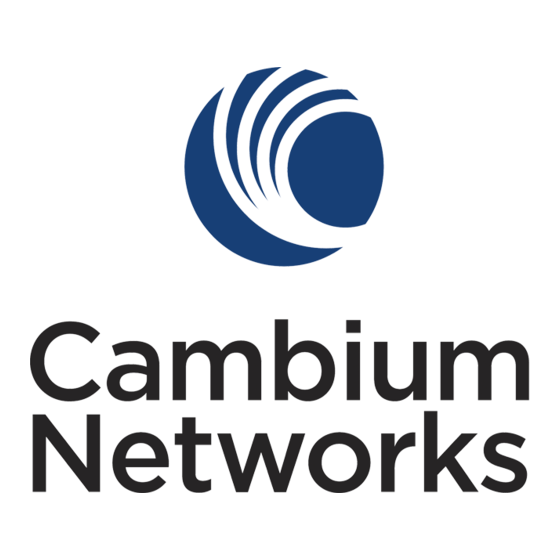

Cambium Networks PTP 820 Manual
Bringing up your first link
Hide thumbs
Also See for PTP 820:
- User manual (1149 pages) ,
- Installation manual (179 pages) ,
- Installation instructions (3 pages)
Advertisement
Quick Links
Advertisement

Summary of Contents for Cambium Networks PTP 820
- Page 1 PTP 820: Bringing up your first link! 13 February 2015...
- Page 2 What’s needed to bring up a microwave link? To access the link: IP addresses: 10.120.109.100, 10.120.109.101 Logins and passwords: admin and admin Tx and Rx frequencies: 19400 MHz, 17840 MHz Channel bandwidth: 30 MHz Modulation mode(s): Adaptive, from QPSK (4 QAM) to 2048 QAM Transmit powers: 2 dBm Link ID (identifier): 1 Ethernet In‐band or Out‐Of‐Band management? Ethernet ports to be used VLAN...
- Page 3 Bringing up your first link! The following steps configure a PTP 820 link as a simple transparent Layer 2 bridge: Login Configure the IP address Apply license key(s) Select/configure MRMC scripts (channel bandwidth, ACM, and modulation mode) Configure Tx/Rx Frequency, Tx Power, and Link ID Configure ATPC and Reference Rx Level Configure the Ethernet service – OOB Management In‐band Management –...
- Page 4 Here’s how your laptop should be connected to a radio Here is a picture of a laptop connected to a PTP 820 radio via • an Ethernet cable.
- Page 5 Enter IP address into web browser (default is 192.168.1.1)
- Page 6 Main View—this is the first screen you see after logging in...
- Page 7 Apply License key(s): Platform,License,License Configuration Paste your license key(s) here...
- Page 8 Configure the IP address: Platform,Management,IP,Local Configure the IP address...
- Page 9 Configure ACM: Radio,MRMC,Symmetrical Scripts,FCC Hit the “Configure script” button...
- Page 10 Configure ACM: Radio,MRMC,Symmetrical Scripts,FCC Configure the channel bandwidth Enable or disable ACM Set maximum and minimum modulation modes...
- Page 11 Configure ACM: Radio,MRMC,Symmetrical Scripts,FCC Here are the modulation modes that are available...
- Page 12 Configure Tx/Rx frequencies and Link ID: Radio,Radio Parameters Set Tx and Rx Frequencies Both ends of the link must have the same Link ID...
- Page 13 Configure ATPC: Radio,ATPC...
- Page 14 Configure Ethernet Service • Ethernet,Services • Add in‐band management—connect port 3 to the MNG service Select MNG Service – – Hit Service Points button – Hit the “Add” button (add service point to MNG service) Interface location: Ethernet: Slot 1, port 3 – – Apply • Move Ethernet cable to port 3 and verify that radio can be managed from port 3 Add Ethernet service to connect port 3 to radio port • Ethernet,Services • • Hit “Add” button • Select Service Type “P2P” • Select P2P Service and hit “Service Points” button Hit “Add” button • • Under“Pre defined options” Select “Option #8 (PIPE, dot1q)” • Under “Interface location” Select “Ethernet: Slot 1, port 3” • Hit “Add” button Under “Interface location” Select “Radio: Slot 2, port1” •...
- Page 15 Configure Ethernet Services: Ethernet,Services...
- Page 16 Left‐click on “MNG” Service and left‐click on “Service Points”...
- Page 17 Add Service Point for in‐band management: left‐click “Add”...
- Page 18 Under “Interface location”, select “Ethernet: Slot 1, port 3” ...
- Page 19 Now you’ve got in‐band management! (left‐click on “Back to Services table”)
- Page 20 Add P2P Service for Ethernet port 3: left‐click “Add”...
- Page 21 Under “Service Type”, pull‐down and select “P2P” and left‐click on “Apply”...
- Page 22 Add PIPE Service Points to P2P Service: with “P2P” selected, left‐ click on “Service Points”...
- Page 23 Add two Service Points: one for the Ethernet port 3, and one for the radio port: left‐click on “Add”...
- Page 24 Under “Pre defined options”, pull‐down and select “Option #8 (PIPE, dot1q)
- Page 25 Under “Interface location”, pull‐down and select “Ethernet: Slot1, port 3”, and left‐click on “Apply”...
- Page 26 Left‐click on “Add” to add radio Service Point...
- Page 27 Under “Interface location”, pull‐down and select “Radio: Slot 2, port1”, and left‐click on “Apply” Notice that under “Pre defined options” “Option #8 (PIPE, dot1q)” has already been selected!
- Page 28 Now you have a P2P PIPE Service connecting the Ethernet port 3 to the radio port!
- Page 29 Repeat steps on opposite end of the link Repeat steps on the opposite end of the link • Remember to reverse the Tx and Rx frequencies – Under “Radio,Radio Parameters” • “Radio Interface operational status” will display “Up” – Ping across link to verify Ethernet connectivity • Configure and connect Ethernet analyzers to test link •...







Need help?
Do you have a question about the PTP 820 and is the answer not in the manual?
Questions and answers